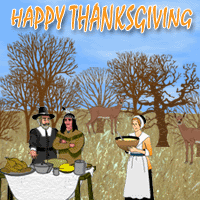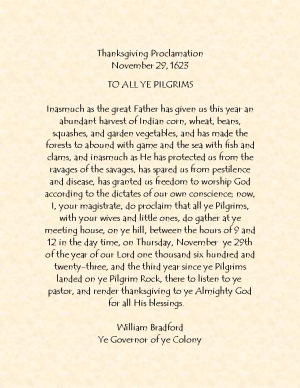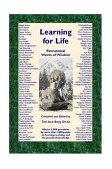

Not Just For Kids
Knowledge House and Homeschool Patriot!

The Thanksgiving Story
The First Thanksgiving In the United States, the fourth Thursday in November is traditionally a time for food and family gatherings. America's Thanksgiving commemorates the Pilgrims' harvest feast, part of the story of the settling of Plymouth Colony, an important period in American history. It's one of our family's favorite holidays. In fact, my husband was born in Plymouth, Massachusetts and we know that he has some Indian roots, so there's a good chance that he may even have a Pilgrim ancestor. The Pilgrims left England in September of 1620, after several delays in getting started. They sailed across the ocean on the Mayflower, finally arriving at Plymouth in December. The cold and snow interfered with the workers as they tried to construct their homes in the wilderness. Half of the Pilgrims died during the long winter. On March 16, 1621, an Indian brave walked into the Plymouth settlement. The Pilgrims were surprised to hear him say "Welcome" in English! His name was Samoset and he had learned English from ship captains who explored and sailed along the east coast. Samoset soon returned with another Indian named Squanto, who also spoke English and became a good friend. Squanto showed the Pilgrims which plants were poisonous and which had medicinal powers. He taught them how to grow corn, how to use fish as fertilizer, and how to tap the maple trees for sap. The Pilgrims had a successful first harvest and they had enough food to put away for the coming winter. The Pilgrims had much to celebrate, as they had built a settlement, they had raised crops, and they were at peace with the native people. Pilgrim Governor William Bradford announced that they should have a harvest feast, and invite their Indian neighbors to join them. Chief Massasoit came with ninety of his braves. The Indians demonstrated their skills with the bow and arrow, and the Pilgrims demonstrated their musket skills. They also played games, ran races, marched, and played drums. Exactly when the festival took place is uncertain, but it is believed to have taken place in mid-October, and it lasted for three days. We can assume that the feast was eaten outside since the Pilgrims didn't have a building large enough to accommodate so many people. The foods they ate would have included venison, wild fowl (ducks, geese, and turkeys), fish, lobsters, mussels, scallops, clams, corn, beans, squash, pumpkin, crab apples, wild grapes, berries, and nuts. The following year's harvest was not as plentiful, and the pilgrims ran short of food after sharing some with newcomers. The third year, spring and summer were hot and dry with the crops dying in the fields. Governor Bradford ordered a day of fasting and prayer, and rain came soon afterwards. To celebrate, November 29th of that year was proclaimed a day of thanksgiving, which in this case was actually a formal religious service. Since the Pilgrims' original feast was never repeated, it can't be called the beginning of a tradition, nor did the Pilgrims call it a Thanksgiving Feast. Nevertheless, the 1621 feast has become a model for our own Thanksgiving celebration. An annually celebrated thanksgiving held after the harvest gradually became a custom in many cities and states. However, it wasn't until 1863 that President Abraham Lincoln proclaimed Thanksgiving Day to be a national holiday.
Did You Know…? Much of the knowledge we have about the Pilgrims is the result of research conducted by the staff at Plimoth Plantation, a living history museum in Plymouth, Massachusetts that re-creates the lives of the Pilgrims. There are also two existing firsthand accounts-the first written by Edward Winslow, presumably a leader of Plymouth Colony; and the second written by William Bradford, Governor of the colony for 33 years. With all of this information, we can accurately piece together what foods would have been served, what recipes were used, how the village looked, what the colonists wore, how they spoke, what animals they owned, what games they played, what their views were on everything from their new home to religion and politics, and even the conversations they had. Four adult Pilgrim women (the only women left after the terrible first winter) were probably in charge of all the cooking at the first harvest feast, serving about 50 Pilgrims and 90 Indian men. The Pilgrims didn't wash their wooden bowls-they just wiped them out. They used stale bread as plates-then they could eat the plates! They would pass one or two cups around for everyone to drink from. Children usually stood at the table and shared a dish.
The Pilgrims liked to recite psalms and sing hymns, such as:
Pilgrim Timeline Plymouth Colony existed from 1620 until 1691 when it was incorporated into the Massachusetts Bay Colony. During this time period, the Dutch artists Rembrandt and Vermeer were painting masterpieces, the Three Musketeers were guarding the king of France, Isaac Newton was making scientific discoveries, the First Folio edition of Shakespeare's plays was published in England, and pirates of all nationalities were using the island of Tortuga as their base of operations in the Caribbean.
AUTHENTIC PILGRIM RECIPES (adapted for modern kitchens) Swizzle (a refreshing drink) You will need: 1 quart water, ¾ cup molasses, ¼ cup white vinegar, ½ teaspoon ginger. Mix all the ingredients in a glass jar. Shake them well. Refrigerate overnight. Serve cold. Hot Nuts (a popular dessert on winter evenings) You will need: 2 cups of unshelled mixed nuts-walnuts, hickory nuts, and hazelnuts. Preheat oven to 400 degrees. Spread nuts in one layer on a heavy cookie sheet. Bake in the oven for 15 minutes. Remove nuts from oven. Put the nuts in a bowl. Give your guests plates and nutcrackers and invite everyone to help themselves to the hot nuts. Cornbread (a nutritious food eaten at almost every meal) You will need: 1 cup cornmeal, 1 ½ cups whole wheat flour, 4 cups water, 1 teaspoon salt. Place cornmeal and water in a pot, and bring to a boil. Lower the heat and cook, stirring occasionally, until it is very thick (about half an hour). Preheat oven to 375 degrees. Mix the whole wheat flour and salt with the cornmeal. Place ½ cup-size mounds of cornmeal mixture one to two inches apart on an ungreased cookie sheet. Gently press down each mound. Bake for 15 minutes. Turn cornbread over (brown side up) and bake for 10 more minutes. Cornbread can be eaten hot, with butter and maple syrup, or simply eat it with your fingers. Makes 30 cornbreads.
America the Beautiful
O beautiful for spacious skies, GIVING THANKS (Author Unknown)
For the hay and the corn and the wheat that is reaped,
For the trade and the skill and the wealth in our land,
For the homes that with purest affection are blest,
A Thanksgiving Prayer Since Indians are so closely associated with the first Thanksgiving, it may be appropriate to offer a Native American message of thanks. The following verse is based on a traditional good morning prayer spoken by the Iroquois Indians of New York State and Canada, and which is recited at ceremonial, governmental, and social gatherings. The prayer normally follows a certain order and is divided into elements of the earth, elements of the sky, and spiritual elements. Each individual speaker may state the prayer in his or her own words. I wrote my own interpretation of this prayer. What are you thankful for? Try writing a poem or prayer of thanksgiving.
Giving Thanks
We give thanks for all of the blessings we receive in God's glorious creation: Copyright 2000 by Teri Ann Berg Olsen
THANKSGIVING ACTIVITIES Write your own poem or prayer of thanksgiving, or simply make a list of things that you are thankful for. Read them to your family on Thanksgiving. Younger children can create a collage of things they're thankful for by cutting out pictures from magazines and mounting them on poster board. This fun, creative project may spark an interesting conversation around the dinner table.

BOOKS ABOUT THE PILGRIMS A Journey to the New World: The Diary of Remember Patience Whipple, Mayflower, 1620 (Dear America Series), by Kathryn Lasky. Eating the Plates: A Pilgrim Book of Food and Manners, by Lucille Recht Penner. If You Sailed on the Mayflower in 1620, by Ann McGovern. N.C. Wyeth's Pilgrims, by Robert San Souci. On the Mayflower: Voyage of the Ship's Apprentice and a Passenger Girl, by Kate Waters. Pilgrims: Complete Theme Unit…with Pilgrim Hall Museum, by Susan Moger. Samuel Eaton's Day: A Day in the Life of a Pilgrim Boy, by Kate Waters. Sarah Morton's Day: A Day in the Life of a Pilgrim Girl, by Kate Waters. Stories of the Pilgrims, by Margaret B. Pumphrey. The First Thanksgiving, by Jean Craighead George. The Journal of Jasper Jonathan Pierce: A Pilgrim Boy (My Name is America Series), by Ann Rinaldi. The Mayflower Adventure and Plymouth Pioneers (American Adventure Series), by Colleen L. Reece. Three Young Pilgrims, by Cheryl Harness.
THANKSGIVING WEBSITES
www.night.net/thanksgiving
http://food.epicurious.com/e_eating/e04_thanks/menuintro.html
www.kidsdomain.com/games/thanks.html
www.annieshomepage.com/thanksgivinggames.html
http://www.gaillovely.com/thanksgiving.htm
www.plimoth.org/education/olc/index_js2.html
RECOMMENDED RESOURCE THANKSLIVING TREASURES: Devotions on God's Provision for the Pilgrims…and for Us, by Leslie J. Barner. This creative resource includes stories of the Pilgrims' journey along with discussion questions and activities to help children and adults grow in gratitude. It contains a 56-page booklet, symbolic objects, postcard-sized reproductions of historical paintings and The Mayflower Compact, all in a keepsake treasure box. For more info, links, recipes, and activity ideas, go to http://www.familylife.com/thanksliving/. (Sadly, it looks like this product has been discontinued. What a shame! Try searching Google or Ebay to see if you can find one.)
RELATED PAGES Monumental: In Search of America's National Treasure - What motivated the Pilgrims to come to America? What formula for success did they discover? More importantly, how can we apply these same foundational truths today? Monumental is a 90-minute documentary that follows Kirk Cameron across Europe and the U.S. as he seeks to discover America’s true “national treasure” – the people, places, and principles that made America the freest, most prosperous and generous nation on earth.

ARIZONA | LEARNING FOR LIFE | PRODUCT CATALOG | LINK LIBRARY | ABOUT US | CONTACT
These pages are a continuous work in progress.
Visit my other website - www.ArizonaEdventures.com - click here to explore Arizona!
|
Sign up for my newsletter and get a FREE GIFT! Click here for details.
Thanks for your votes!
and purchase items via our affiliate links. Thank you!
 
|






 L
L K
K